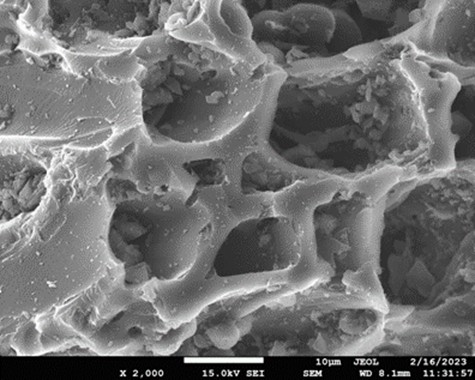Usage of soil amendment to increase fragrance of Khao Dawk Mali 105 and reducing methane emissions in rice fields
Keywords:
Methane, Biochar, Rice fields, 2-Acetyl-1-pyrroline (2AP)Abstract
This research aimed to study the influence of fertilizer management on rice in three different regimes: chemical fertilizer alone, chemical fertilizer combined with sulfur, and the use of soil amendments containing biochar components to mitigate methane emissions in rice fields and improve rice yield. The study was conducted in experimental plots located in Mueang Sri Kai Sub-district, Warinchamrab District, Ubon Ratchathani Province. The experimental design comprised four treatments: 1) C (Control), without soil amendments and any type of fertilizer, 2) F (Fertilizer), conventional method, using only chemical fertilizer, 3) FS (Fertilizer/Sulfur), using chemical fertilizer combined with sulfur, and 4) FBS (Fertilizer/Biochar/Sulfur), using soil amendments containing chemical fertilizer, biochar, and sulfur. Methane emissions were monitored throughout the growing season. Results showed that when comparing the F, FS, and FBS treatments with different fertilizer management practices, the FS and FBS treatments reduced methane emissions in rice fields compared to the F treatment by 19.06% and 5.68%, respectively. Additionally, the FS and FBS treatments resulted in the highest rice yields, with average grain yields of 91.13 and 91.00 grams per pot, respectively. Analysis of 2-Acetyl-1-pyrroline (2AP) content revealed significant differences (P<0.05) among the treatments, with the FBS treatment producing the highest 2AP content compared to the other treatments. This study demonstrates the effectiveness of soil amendments in reducing methane emissions in rice fields compared to using chemical fertilizer alone, while also increasing 2AP content in rice grains. These findings highlight the importance of soil amendments in enhancing agricultural value and addressing environmental challenges.
References
Virmani N, Agarwal S, Raut RD, Paul SK, Mahmood H. Adopting net-zero in emerging economies. Journal of Environmental Management. 2022 Nov;321:115978.
Ministry of Natural Resources and environment. Thailand’s Long-Term Low Greenhouse Gas Emission Development Strategy (revised version), Office of Natural Resource and Environmental Policy and Planning; 2022. 63 p.
Ministry of Natural Resources and environment. Thailand’s Fourth Biennial Update Report, Office of Natural Resource and Environmental Policy and Planning; 2022. 126 p.
Cael BB, Goodwin PA. Global methane pledge versus carbon dioxide emission reduction. Environmental Research Letters. 2023 Sept 25;18(10):104015.
Feng Y, Xu Y, Yu Y, Xie Z, Lin X. Mechanisms of biochar decreasing methane emission from Chinese paddy soils. Soil Biology and Biochemistry. 2012 Mar;46:80–8.
Qin X, Li Y, Wang H, Liu C, Li J, Wan Y, et al. Long-term effect of biochar application on yield-scaled greenhouse gas emissions in a rice paddy cropping system: A four-year case study in south china. Science of The Total Environment. 2016 Nov;569–570:1390–401.
Lehmann J. A handful of carbon. Nature. 2007 May;447(7141):143–4.
Wu Z, Zhang X, Dong Y, Li B, Xiong Z. Biochar amendment reduced greenhouse gas intensities in the rice-wheat rotation system: Six-year field observation and meta-analysis. Agricultural and Forest Meteorology. 2019 Nov;278:107625.
Tragoolram J, Saenjan P. Effects of Sulfate Fertilizer on Rice Yields (Sakol Nakhon varieties) and Global Warming Potential. KKU Research Journal. 2012;419-22. (in Thai)
Rice Department, Soil and fertilizer management in rice fields [Internet]. Rice Knowledge Bank. 2016 [cited 2022 May 5]. Available from: https://www.ricethailand.go.th (in Thai)
Dong D, Li J, Ying S, Wu J, Han X, Teng Y, et al. Mitigation of methane emission in a rice paddy field amended with biochar-based slow-release fertilizer. Science of The Total Environment. 2021 Oct;792:148460.
Zheng X, Huang Y, Wang Y, Wang M. Seasonal characteristics of nitric oxide emission from a typical Chinese rice–wheat rotation during the non‐waterlogged period. Global Change Biology. 2003 Feb;9(2):219–27.
Singh NK, Patel DB, Khalekar GD. Methanogenesis and methane emission in rice / paddy fields. Sustainable Agriculture Reviews. 2018;135–70.
Li C, Zhu J, Li X, Deng J, Yang W, Zhou Y, et al. CH4 and n2o emission and grain yield performance of three main rice-farming patterns in central China. Agronomy. 2023 May 25;13(6):1460.
Humphreys J, Brye KR, Rector C, Gbur EE. Methane emissions from rice across a soil organic matter gradient in Alfisols of Arkansas, USA. Geoderma Regional. 2019 Mar;16.
Gu X, Weng S, Li Y, Zhou X. Effects of water and fertilizer management practices on methane emissions from Paddy Soils: Synthesis and perspective. International Journal of Environmental Research and Public Health. 2022 Jun 15;19(12):7324.
Sun X, Zhang W, Vassov R, Sherr I, Du N, Zwiazek JJ. Effects of elemental sulfur on soil pH and growth of Saskatoon Berry (Amelanchier alnifolia) and beaked hazelnut (corylus cornuta) seedlings. Soil Systems. 2022;6(2),31.
Scholz VV, Meckenstock RU, Nielsen LP, Risgaard-Petersen N. Cable bacteria reduce methane emissions from rice-vegetated soils. Nature Communications, 2020;11(1).
Wind T, Stubner S, Conrad R. Sulfate-reducing bacteria in rice field soil and on rice roots. Systematic and Applied Microbiology. 1999;22(2):269–79.
Nogués I, Mazzurco Miritana V, Passatore L, Zacchini M, Peruzzi E, Carloni S, et al. Biochar soil amendment as carbon farming practice in a Mediterranean environment. Geoderma Regional. 2023;33.

Downloads
Published
How to Cite
Issue
Section
License
Copyright (c) 2024 University of Phayao

This work is licensed under a Creative Commons Attribution-NonCommercial-NoDerivatives 4.0 International License.
ผู้นิพนธ์ต้องรับผิดชอบข้อความในบทนิพนธ์ของตน มหาวิทยาลัยพะเยาไม่จำเป็นต้องเห็นด้วยกับบทความที่ตีพิมพ์เสมอไป ผู้สนใจสามารถคัดลอก และนำไปใช้ได้ แต่จะต้องขออนุมัติเจ้าของ และได้รับการอนุมัติเป็นลายลักษณ์อักษรก่อน พร้อมกับมีการอ้างอิงและกล่าวคำขอบคุณให้ถูกต้องด้วย
The authors are themselves responsible for their contents. Signed articles may not always reflect the opinion of University of Phayao. The articles can be reproduced and reprinted, provided that permission is given by the authors and acknowledgement must be given.







